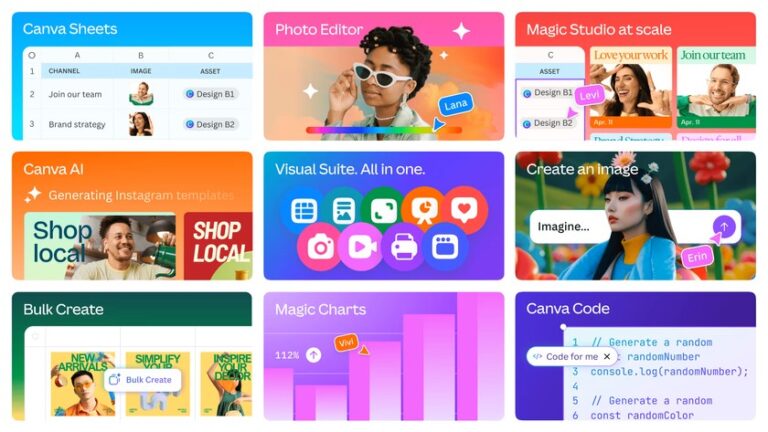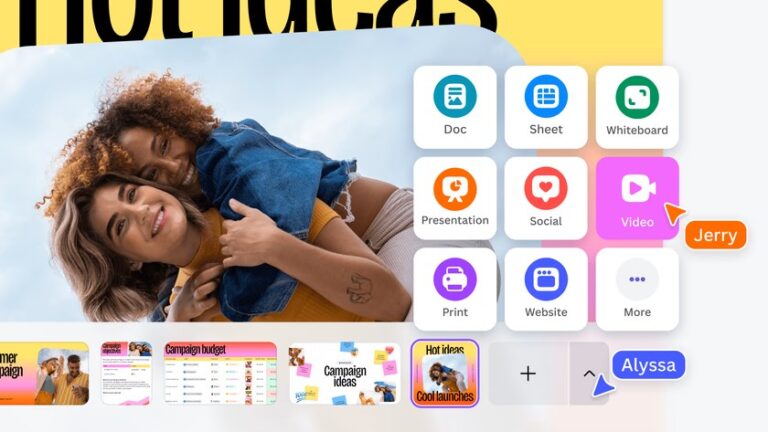Canva has recently stepped beyond its design platform origins with Visual Suite 2.0, an ambitious integration of AI, design, and productivity tools that challenges established players like Microsoft, Google, and Adobe.
Canva appears to be determined to push to capture a larger share of the workplace collaboration market, building upon its impressive community of 230 million users. With this in mind, the updated Visual Suite reimagines how teams collaborate, allowing users to seamlessly work across multiple formats—presentations, videos, whiteboards, and websites—all within a single, unified interface. This approach eliminates the traditional boundaries between creative design and workplace productivity that have long kept these functions in separate software environments.
Breaking Down Silos with All-in-One Design Format
Visual Suite 2.0’s most transformative feature may be its unified format, which enables users to build and edit documents, presentations, animations, and websites within a single design. This groundbreaking approach allows entire project lifecycles—from initial planning and brainstorming to final design and delivery—to unfold within one collaborative space.
“This eliminates the need for separate tools, fragmented workflows, and disconnected files,” Canva explained in its announcement. The platform’s architecture now supports simultaneous collaboration across multiple tasks, reflecting Canva’s understanding of how modern teams actually work rather than forcing them into rigid application boundaries.
Canva Sheets: Reimagining Data Visualization
Responding to consistent user feedback about missing functionality, Canva has introduced Canva Sheets—a creative reinvention of spreadsheet technology that brings data management firmly into the visual communication ecosystem. Unlike traditional spreadsheets that exist in isolation from design workflows, Canva Sheets integrates directly with the company’s visual tools.
What distinguishes Canva Sheets is its AI-driven approach to data handling. The platform’s “Magic Insights” feature automatically scans imported data to identify noteworthy patterns and takeaways, while “Magic Formulas” transforms complex calculations into simple text-based requests. This represents a fundamental reimagining of how users interact with numerical information.
The platform also supports live data connections from services including Google Analytics, HubSpot, Snowflake, and Statista, enabling users to maintain updated visualizations as their underlying data changes.
Magic Charts: Transforming Raw Data into Compelling Narratives
Building on the foundation of Canva Sheets, Magic Charts introduces intelligent visualization recommendations based on data characteristics. The system analyzes selected information and suggests optimal chart types to represent relationships and trends effectively.
This feature dramatically simplifies the process of transforming raw numbers into infographics, reports, and animated visualizations. Rather than requiring users to understand data visualization principles, Magic Charts applies best practices automatically, making sophisticated data storytelling accessible to non-specialists.
Canva AI: A Conversational Creative Partner
Canva has consolidated its various AI capabilities into a unified interface called Canva AI, described as a “conversational creative partner.” This chatbot integrates all of Canva’s generative AI tools into a single window, allowing users to access them through voice or text prompts.
From generating text and images to editing photos and resizing designs, Canva AI represents the company’s vision of design flowing “at the speed of conversation.” This approach makes creative tools more accessible to users regardless of technical expertise, reflecting Canva’s founding mission of democratizing design.
The integration of AI across the platform is substantial—users have already employed Canva’s Magic Studio features more than 16 billion times, demonstrating significant adoption of AI-assisted creativity.
Canva Code for Everyone: Venturing into Interactive Content Creation
Perhaps most surprising is Canva’s entry into the coding space with Canva Code, a generative AI coding assistant comparable to Google’s Gemini Code Assist or Microsoft’s GitHub Copilot. This tool allows users to create interactive widgets, websites, and other content through simple text prompts, without requiring coding expertise.
Canva Code opens new possibilities for creating interactive experiences—from educational games to customized business tools—that can be shared as standalone links or embedded within other Canva designs. This approach significantly lowers barriers to creating functional, interactive content.
Enhanced Photo Editing Capabilities
Complementing these productivity enhancements, Canva has also updated its Photo Editor with advanced capabilities reminiscent of Adobe’s professional software. Users can now modify or remove background objects with simple clicks, generate AI backgrounds that account for lighting and layout, and make precise edits without switching between applications.
The new Background Generator seamlessly blends subjects into fresh scenes with appropriate lighting and mood, while intuitive point-and-click controls allow users to reposition, replace, remove, recolor, or resize elements within images.
Productivity Gains
Visual Suite 2.0 positions Canva as a serious competitor in the productivity tool space, challenging established platforms with an approach that prioritizes visual communication and accessibility. By integrating design and data functionality that previously required multiple specialized applications, Canva offers a compelling alternative for teams tired of juggling different software ecosystems.
The platform’s emphasis on AI assistance throughout the creative and analytical process differentiates it from more traditional office suites. Rather than simply digitizing existing workflows, Canva’s tools fundamentally reimagine how users interact with information, making sophisticated capabilities accessible through natural language and intuitive interfaces.
What’s for the Future?
As Canva continues expanding beyond its design platform origins, its success will depend on how effectively these new tools deliver on their promise of seamless integration. The company’s challenge lies in maintaining the simplicity and accessibility that built its initial user base while adding powerful new capabilities that satisfy professional requirements.
What’s clear is that Canva is no longer content to be categorized solely as a design platform—it now aims to be the central hub where workplace productivity and creative expression converge. With Visual Suite 2.0, Canva has made a compelling case that these domains belong together rather than in separate applications.
If you are interested in this topic, we suggest you check our articles:
- Scalenut: Boost your SEO Performance with AI Content Research & Copywriting
- Frase: AI SEO Assistant for Optimized Content Creation
- Hypotenuse AI: A Marketing Solution using AI for CMS Platforms
Written by Alius Noreika


